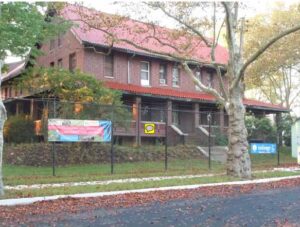Marconi Eras
Wall Township’s Camp Evans played key role in historic events Wall Township’s Camp Evans
Wall Township’s Camp Evans
played a key role in historic events
The Coast Star
January 8, 2004
By Fred Carl
Page 5, cont. page 25
Two historic events that occurred at Camp Evans during January of past years will be remembered at the Wall Township historic site this month. The first is the 58th anniversary of the opening of space communications on Jan. 10, 1946. The second historic, event is the 90th anniversary of the beginning of worldwide wireless communications on Jan. 30 and 31,1914.
Both events would be retold in books and films. A famous and tragic inventor, Edwin Armstrong, played a key role in both events. On Saturday, the Ocean, Monmouth Amateur Radio Club,[OMARC] will host an open, house at the Diana site on Marconi Road. Between noon and 4 p.m., visitors can meet the members of OMARC, enjoy radio contacts with other counties, see historic photos and view 1946 newsreels of Project Diana.
The Astro-Observation Center buildings at the Diana site have been freshly repainted by Infoage volunteers in ugly, but historic, 1950s Army light green. A donation by The Association of Old Crows, a $500 gift from the Wall Township Kiwanis Club and donations by Mr. Robert Howd of Wall provided funds for paint and materials. Fort Monmouth granted permission to paint the buildings in July.
Until a January day 58 years ago, many scientists believed radio waves could not pass through a layer in the atmosphere named the ionosphere. Governments would not consider funding satellite programs because the satellites would have to orbit above the ionosphere. If the devices could not receive radio signals or send then to earth, they would be useless.
Radar engineers from Camp Evans modified WWII experimental radar, designed by Edwin Armstrong, to attempt to bounce a radar signal off the moon. Their goal was to prove space communications were possible with the right equipment.
They also had another reason.
They wanted to prepare Army radar to help defend the United States from a Soviet missile attack, as the cold war was just beginning at this point.
After months of work, on Jan. 10, 1946 the Camp Evans team succeeded. Space communication was possible. The United States and the Soviet Union then began programs to launch satellites and put men in space. At this same site every American and Soviet launch would be tracked, including Sputnik.
On another January day just 32 years before Project Diana began space communications, a group of men arrived in Wall. Their goal on January 30, 1914, was to test a new wireless circuit hidden in a `black box’ at the new Marconi Station. The station had six 400 foot tall towers on the edge of the Shark River. The team was lead by David Sarnoff. They began the testing of Edwin Armstrong’s regenerative circuit in the evening. They were so astounded by the improvement this circuit made in reception they worked the entire night.
For the first time, one could clearly hear messages from as far away as Hawaii and Germany. World-wide wireless communication was possible. Before this, it was difficult to receive a message by wireless sent across an ocean. In the future, Edwin Armstrong would develop other breakthrough circuits such as the super-heterodyne and his most famous invention, the FM radio. David Sarnoff and Edwin Armstrong became friends and would celebrate the anniversary of their first visit to Wall every year until they became hated foes. During his 1914 visit to Wall, Edwin Armstrong kept his patented invention hidden in a black box to prevent Sarnoff or others from stealing it.
During WWII Edwin Armstrong allowed the United States to use all his patented inventions at no cost to help defeat the Axis powers. After the war, David Sarnoff refused to pay his former friend, Edwin Armstrong, the royalties he was due for the use of FM circuitry. Sarnoff, then the powerful president of RCA, had incorporated FM into every television. After years of battling in the courts, the genius would commit suicide on the 40th anniversary of his first visit to Wall in frustration with David Sarnoff.
The Diana site would be used in the late 1950s and early 1960s to communicate with America’s first satellites and track interplanetary space probes. In the mid-1960s, its space exploration work would be transferred to NASA. In just over 45 years the historic site on the edge of the Shark River would host the advances of man’s communication technology from trans-oceanic wireless, to worldwide wireless, to space and finally satellite technology. On Saturday, you are invited to visit this special place in Wall on Marconi Road.
[Fred Carl is Wall Township’s official historian.]
page created January 17, 2004
We Need Your Help! Volunteer with Us.
Join our mission to preserve historic Camp Evans and teach the public about science and history.
Sign up to join our team of volunteers and start on your own mission today.
InfoAge Science & History Museums
2201 Marconi Road
Wall, NJ 07719
Tel: 732-280-3000
info@infoage.org
webmaster@infoage.org
